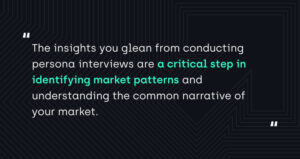As seen on Pragmatic Institute.
I do a lot of persona interviews. I interview clients and people on behalf of clients. I conduct interviews with customers, buyers and internal teams. Name any job title in the technology industry and I’ve probably interviewed someone in that position.
Our team uses these interviews as a basis for getting an outside-in look at what individuals are actually thinking about a product or service—how they buy or use a product, what gets their attention, what their vetting process looks like. The insights that emerge from these discussions are often priceless.
When I realized that I had surpassed 100 hours of 15- to 20-minute interviews, it dawned on me: Surely I have uncovered a few things about the interview process that will benefit others. So, I compiled a list of things I’ve learned.
These nine bits of guidance help me derive the best results and mitigate pitfalls. Hopefully, they can do the same for you.

1. Get help scheduling interviews.
Getting people to schedule their time to speak with you is more laborious than you might think. I make initial contact with interviewees via email and then have someone else on our team nail down an interview time and date. Doing it all on your own can be overwhelming.
2. Be clear about what you are doing and how long it will take.
Buyers are well aware that anyone who calls them from a supplier might have a hidden agenda that involves selling them something. The words: “My purpose isn’t to sell you on anything …” should be in every initial interview request. Also, I always ask for 20 minutes of their time. You can get a lot answered in that short time frame and it lets the interviewee know exactly what they are in for. If the conversation goes longer, it’s usually because they want it to.
3. Realize that you don’t need tons of interviews to get directional guidance.
At a minimum, conduct six interviews to get a good view of a specific persona. If you can interview 8 to 10 of the same type of persona, you are in a fantastic spot. It can be difficult to get more, and typically you don’t see many new insights surface after that.
4. Know that qualitative results are usually in line with quantitative.
Sometimes, directional information can be enough to make a business case for change. Speed often matters when you are making a decision from research insight and it is a common pitfall for organizations to react too slowly to important feedback while waiting on deeper research. Don’t be afraid to make inferences from what you hear in qualitative interviews. A decent guideline when developing buyer insights is if you need to make decisions that are expensive to change, you should absolutely do both qualitative and quantitative research. However, if you are looking for directional ideas, then qualitative may be enough to start testing the validity of what you have heard.
5. Create a list of questions, but be ready to stray from it.
Give yourself a guide with content areas and questions that you need to cover with interviewees. Realize though, that some people will have more experience or more to say about certain aspects than others. Be ready and comfortable going off script to get the most out of the interview and fully understand your interviewee’s perspective.
6. Record interviews—don’t try to take notes.
When you take notes you aren’t really listening. You won’t pick up on cues that could lead you to interesting follow-up questions, or provoke a different response. After the interview you can pay a service to transcribe the recording and you will have the entire interview documented. At the beginning of your call, let your interviewee know they are being recorded and that it will not be shared with anyone else.
7. Frame your questions in a manner most likely to produce usable results.
This might be the most important piece of advice I share. Your goal is to learn about the person you are speaking with, and get information about their behaviors. This is what will help you build a strategy to find more buyers like them. For example, you might ask what they do when they want to solve a business problem, or who is involved in buying decisions and what each of these people care most about. If you craft your questions carefully, the answers will form the basis for your marketing plan.
8. Ask questions acknowledging that you don’t know what you don’t know.
When probing for insights, you need to ask some open-ended questions. For example, here is the last question that I ask in every interview: “What didn’t I ask you that I should have asked?”
9. When you finish your interview, thank the interviewee for their help and ask for permission to follow up.
Time is the one thing all successful people do not have enough of. When someone graciously gives you their time, make sure you acknowledge that gift. Still, chances are, they will say something in the interview that you may want more information on. Ask if you can follow up via email with any questions you might have. Interviewees typically appreciate that you ask and will grant your request.
To truly understand your buyers and users, you must first understand them as human beings. That means learning their motivations, aspirations, pain points and plans. The insights you glean from conducting persona interviews are a critical step in identifying market patterns and understanding the common narrative of your market. Hopefully, these tips will help you in your interviewing efforts.


